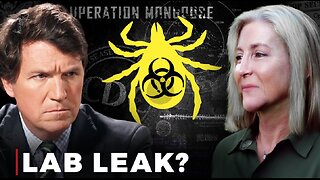Tucker Carlson Uncensored - Was Lyme Disease Created as a Bioweapon
In the late 1960’s, government bioweapons labs started injecting ticks with exotic diseases. Soon, people nearby began to get those diseases. Now, tick-borne Lyme is endemic. Naturally the government has admitted nothing.
mirrored from Tucker Carlson Network
reposted under FAIR USE Copyright laws
link to original here >>> https://tuckercarlson.com/uncensored-kris-newby
Transcript
Tucker [00:00:00] If you live in certain parts of this country, rural areas particularly, you know, people who have or who have had Lyme Disease, and for some of them, maybe most, it's not a huge deal. You go in and you get a big dose of antibiotics, you have some symptoms, and then it seems to go away. But for some percentage of these people too, it's totally life destroying. It's years in bed. It's agony. It's really the end of your productive life. So what is that exactly? What is Lyme disease? Well, there's still an active debate about that very basic question. Some have dismissed it as a as a psychological symptom, actually. But even people have acknowledged that it's a it's a physical syndrome. Aren't always very clear, and they're certainly not in agreement with one another about what it is or where it came from. So back in 2008, a woman called Kris Newby produced a documentary about Lyme. At that point, it was becoming a very serious global illness and its origins were mysterious, unknown people. Wister whispered about it, but no one could be certain that documentary was called Under Our Skin. Here's part of it:
Documentary Soundbite [00:01:03] Some infectious disease doctors, they don't believe in Lyme. And they said that I was faking it and pretending so I could get out of school and say Lyme is the fastest growing infectious disease in the country. 200,000 new cases a year, maybe even more. It is a political disease and an economic disease as much as it is a bacterial borne infection. I would never, never have thought that something like a bacteriological infection can become so politicized. The truth can be so brutally distorted. I go into despair daily, I cry daily, I want to die daily. Well, when I saw the doctor, you know, he said, you've got a long road ahead of you. It's not going to be easy. So that scared me. The unknown is pretty scary. It is a national health crisis that is completely and totally being ignored and squashed. What is going on?
Tucker [00:02:06] Well, you could write it off. And again, some have as a figment of your imagination, but there are real neurological symptoms. And if you know anyone who's had it, you know that it's entirely real. So again, what is this? Well, Kris Newby has spent a lot of time thinking and researching on this topic. Has been affected personally by Lyme. Is the author of Bitten: The Secret History of Biological Weapons and Lyme Disease, and she joins us now. Kris Newby, thanks so much for coming on. So can you just give us-
Kris Newby [00:02:37] Thanks for inviting me here.
Tucker [00:02:38] Oh, absolutely. A quick and succinct overview of what Lyme is.
Kris Newby [00:02:44] So Lyme disease is caused by, aspiring cattle bacteria. And you get it through a tick bite. And if you treat it, immediately with, doxycycline or amoxicillin, it will go away. The problem is it's very often, misdiagnosed or diagnosed late. And that that's where the controversy comes in for the disease. It, it can linger for months to years, and then it's really hard to get rid of and and to complicated a tick can transmit up to, like, 20 different disease causing microbes. And so if you have like two or 3 or 4 of those in one tick bite, it creates a confusing set of symptoms that doctors have trouble diagnosing.
Tucker [00:03:33] So doctors can isolate however, the organism that causes Lyme specifically. I mean, there's no mystery about where that comes from. Is that correct?
Kris Newby [00:03:44] Well, there are antibody tests for Lyme disease. It's really, really hard to culture the, you know, take blood and culture it in a petri dish. Yes. The problem is the tests are not very reliable. The the Lyme disease antibody tests don't usually work in the first month. It takes a while for your body to develop antibodies to the level that they can be measured. And then later on, the tests aren't that great. It's no better than a coin flip because it just depends on, what strain you have and what you're, if you're really sick, you can't produce antibodies.
Tucker [00:04:22] Interesting. So the problem with tick borne diseases is there are a lot more ticks than there have been in in our lifetimes. Anyway parts of the northeast have seen an explosion in tick populations, to the point where large mammals are being decimated, sucked dry of blood, and dying because they have too many ticks on them. So that's not anyone's imagination. That's measurable. So if you have a disease that spread by ticks and there are a whole lot more ticks, you're going to get a whole lot more cases. The disease is this measured, measurable?
Kris Newby [00:04:53] Yes. And I would say just the the cases of Lyme disease are going up, which is proving that ticks are biting people. The CDC estimates they're half a million cases a year. That's on average 1300 people a day. So that's significant now why they're spreading so quickly. I go into that in the book a little bit. I mean, there certainly is global climate change, which means winters aren't as severe and a lot of the ticks don't die off. Yes, that's true in, in Maine. And then part of it is people are moving into the woods and are exposed more to the ticks.
Tucker [00:05:35] Yes. Oh. All true, in Maine and other northern states. But it does raise the question, like, how did this I mean, if you're if you're 75 years old, you did not grow up with Lyme disease. If you're 15 years old, you're worried about Lyme disease. That's a pretty short period. Where do we think this came from?
Kris Newby [00:05:57] Well, I, the thing I found in my research for my book is Lyme disease wasn't a problem. Problem? A noticeable problem till the mid 70s. And what my research said is that there are actually three really virulent tick borne diseases. That's that showed up right around Lyme, Connecticut, at the mouth of the Connecticut River, which is right across from Plum Island, which was the US's, anti animal crop, headquarters for the biological weapons program. So late 60s, the the peak of the biological weapons program in the US. These three freaky diseases showed up. So that was Lyme Arthritis. There was, rickettsiae, which is, rocky mountain spotted fever. And then there was a, cattle parasite. It was the second time it was found in man in that area called the Bebesia. And that's that's actually I got Lyme and Bebesia, which can be fatal and it's a serious disease.
Tucker [00:07:03] So all three, so you have a cluster effectively of these three previously rare diseases right across the water from the US government's biological weapons testing facility. Is that that what you're saying?
Kris Newby [00:07:19] Yeah. And, if you're, like, working for the CDC and on look on the lookout for natural versus unnatural, disease outbreaks having three new tick borne diseases show up, extra deadly disease causing, than in the past it would raise, it would raise it would get their attention and there would be investigations, which is what happened.
Tucker [00:07:50] That sounds like a crazy conspiracy theory to me. Just because you have previously rare diseases show up all at once across from a biological weapons facility doesn't mean. So. Okay, so the CDC investigated this. What did they find?
Kris Newby [00:08:05] Well, it was a housewife in Lyme, Connecticut, Pauli Murray was the first one to start documenting. And she started pounding on the doors of local health departments and the CDC. And it really took her seven years before the CDC responded. And a doctor named Ellen Steer showed up and started, from Yale. He's a CDC Ice officer and started investigating it. And he they he figured out it was tickborne, but he couldn't figure out the causative agent. And at that point, the US's number one tick researcher, Willy Burgdorfer, a Swiss American tick guy who was in, NIH, his Rocky Mountain laboratory came out to investigate. And that's where he found I mean, the public facing story is he found the Sparky, causes this bullseye rash. He said that's what's causing all the disease. And, the panic should stop. Just take two weeks of detoxes, cycling, and the problem will go away. But it didn't. And that's where my book took off. I started looking at the back story and wondering what really happened. And, people associated with that disease were acting in the normal way. Normally when you discover a, a dangerous new disease, you say, oh, this is horrible. Give us money, we'll research it, but instead it just became more and more secretive.
Tucker [00:09:40] Yes. So did, is it your belief that Willy Burgdorfer, for who I think is, is gone now, but it knew the truth about what happened and, what do you think is the truth?
Kris Newby [00:09:51] Well, I, I worked on the the Lyme disease documentary, with fresh eyes because I didn't know any about anything about the disease till my husband and I got it. And the thing that was unusual is the symptoms sat on the CDC website and in the medical textbooks was totally different than what we had experienced. So then I teamed up with the director, Annie Willis Wilson, and we spent three and a half years researching the disease and and what we found out, it was just an enormous epidemic. So many people are suffering. And the treatment recommended by public health, which was two weeks of doxycycline, wasn't curing it. But these patients who went on to get the same symptoms over and over again, were not given any more antibiotics. And then we wanted to understand, like what was going on with the disease. So any and I called all the CDC people, the NIH people, they wouldn't talk to us like one of the original discovers even hung up on me. I said, I just want someone to go on camera and talk about how this disease, how this organism causes a disease. But to have a professor, you know, who discovered the disease hang up on me. It was just unusual. There was paranoia amongst the specialists. So what we did was we went out to see Willy Bergdorf, who was retired, the guy who discovered Lyme disease at his home. And while we were setting up the cameras, someone from the lab knocked on the door, says, I need I need to sit in on this, this interview. There's things Willy can't talk about. And the director was outraged and kicked him out. But during that interview, Willy intimated that the there was more to Lyme disease than the public health was letting on, that the disease is not just a rash, highly neurological, especially damaging for children. And two weeks of docs. Cycling doesn't work and they know it can go on to be chronic. So it was our first hard proof that something wasn't as it seemed on the surface with Lyme disease. And, so we got the film out. And one thing, one of the aspects that we covered in the film is just conflicts of interest in Madison, because right around the time Lyme disease was discovered, researchers at universities, the CDC, the NIH, could share in the profits of a new test or a vaccine for a disease. So there was a lot of, like an, CDC employee could, match their salary in royalties for a vaccine or a test kit. So it corrupted the incentives in Madison not to share information about a new disease, but instead to save it as intellectual property so it can be monetized. So. So anyways, we got the film out. There were rumors swirling around about Plum Island and it being Lyme disease being a biological weapon, but we had enough to cover with the patient story and the conflict story. And then I was done with it. And, I got a great job writing science for a Stanford medical school in the science department. And I was going to walk away and get on with my life. But then, two things happened within the space of a month, and I. I said, I can't let this story go. I just have to know what is really going on with this disease. And one was I met a CDC, I mean, a, CIA black ops guy who said in 1962 the weirdest thing he'd ever done in his whole crazy Apocalypse Now career was dropping poison ticks on Cuban sugarcane workers. That was Operation Mongoose. So that was the first evidence that we had dropped ticks on a, foreign country as a bioweapon. And then the other thing is, one of my filmmaker friends went out to Willy Burgdorfer. And in a very long interview, he at the very end, he said, yeah, when I investigated the Lyme disease sickness, in the late 70s, early 80s, there was another organism there. It wasn't just Lyme that was making people sick. It was. I and I was told to cover it up. It was probably a ricochet. You didn't release all the information, but what he said was confirmed by copies of those lab books and, and, subsequent interviews that I had with him.
Tucker [00:14:29] And so, pardon my ignorance. What is the disease? You describe the other one. Rickettsiae.
Kris Newby [00:14:38] So it's Rickettsiae. It is, the same organism that causes Rocky Mountain spotted fever. And that's the most deadly tick borne disease in the United States. It also was a germ that was being weaponized by the, the U.S. military at the time. And and they tried to stuff it in texts. I mean, so what is tick weaponization? So in the interviews with Willie, what he said was, I spent over a decade in the biological weapons program, a contractor to Fort Detrick, working on, weaponizing fleas, ticks and mosquitoes, trying to mass produce them. Stuffing, please, with the plague, stuffing mosquitoes with deadly Trinidad virus, Trinidad virus, and then stuffing ticks with either deadly or incapacitating, hesitating diseases like relapsing fever, Venezuelan equine encephalitis, rabies, leptospirosis, which is another skyrocket. So it's just like Doctor Strangelove. Trying to make new diseases, mixing bacteria and viruses in ticks with the intent of. This is the perfect stealth weapon. It's poor, poor man's nuke. You drop these insects on an enemy, it weakens the population. It ties up the medical resources, but doesn't destroy infrastructure like a nuclear bomb would. And in one report from a bean counter in the military, they said. Tularemia, which is tickborne. Tularemia. Also rabbit fever. We can kill 10,000 people at $1.33 a life. So anyways, it was just, there was more to tick borne diseases than we realize. And I began suspecting that Willy was right. Given this context.
Tucker [00:16:46] It's hard to digest all of this. It's just so evil. It's hard to believe it could happen in the United States. But I think you're. You're right that it did. And maybe still happening. Let me ask what you think happened in the specific case of Lyme. So these kinds of experiments were taking place on Plum Island. Is that confirmed?
Kris Newby [00:17:09] Well, Plum Island only did animal diseases. There is another branch which is Maryland, Fort Detrick. They did anti-human, weapons. But. I. I'm not sure exactly what got out where, because if you draw, like a five mile circle around Lyme, Connecticut, there's Plum Island. There's several military bases. There are many pharmaceutical companies who were that were funded by the military to develop, treatments for these diseases. And so they would have to have the diseases on site. So that's my continuing. Research there. And there are, there are a couple. Well, first of all, backup to weaponize a living system like a bug or the Germs and bugs. Or later on, in the 60s, they separated the germs and aerosolized and they would freeze, dry them, pasteurize them, and then spray them on. The plan was to spray them on enemies from planes or bogies or vehicles. So to develop a weapon like that, you have to have someone like Willy Bergdorf, her saying, if they can get these living systems to work and develop the lethal dosage of those organisms, then you have to do pilot studies. That usually happened, could happen, you know, in Connecticut or at Fort Dietrich in Maryland, and then there would be larger studies, and that would be at like Dugway Proving Grounds in Utah. So there was a lot of leak points for any accidents that could have happened in this biological weapons program. So, what Willie said, and I think he's a really credible witness because he had the most to lose by admitting towards the end of his life that I covered up something really important, and now I feel guilty about it. Yeah. All his fame came at 56 when he discovered Lyme Disease. So what he said is, and he wouldn't give me the details of the organism that was the bio weapon. But he said accidents happened. So my continuing work is to try and figure out, okay, where was the leak? And and most crucially, is like, why were there multiple tick borne diseases in that very, very small spot? Also, there were some in northern Wisconsin where we had a biological weapons. That's the anti crop area in the genetic engineering area of the bioweapons program. So So what I sought, sought through and documents and grants and newspapers.com are. Were there century die offs of animals and people that are hidden there because, oh, the biological weapons program was a secret as the Manhattan program, and a lot of the documents were destroyed after the program was canceled in 72. I have to say, one of the most outrageous open air experiments, which I think contributed to the problem around Lyme, Connecticut, is coastal Virginia. Tick researcher had an Army contract and a contract with the Atomic Energy Commission, and he was testing Lone Star ticks, as a potential, weaponized organism. And the thing about. Lone Star ticks as they're from the. They were from the South. Originally identified them in Texas below the Mason-Dixon line. But here he was on the Mason-Dixon line. Testing by the hundreds of thousands a non-native tick. And he wanted to see how far are they, how far they can creep in months to years. Because if you're weaponizing it, you would want to know that information. So from Willy Bergdorf here in Montana, he got some pregnant ticks. So they have, they're called gravid ticks, but they have 2000 to 4000 eggs inside of them. He would inject them with a, radioactive isotope. The chicks would hatch all their larval babies, and then he would and they would be radioactive for life. So first of all, you're going to release them in nature isn't going to cause mutations in the organisms inside their gut. But anyways, what he would do is he would take a thousand ticks and put a thousand per grid in a marshy field, and then he and his assistants would go out every month. They'd use a Geiger counter to figure out how far the ticks had creeped in that amount of time, and then write studies on them, which are actually in the public domain. But, this is an open air test on the Atlantic bird Flyway, 1966, 6768. And sure enough, like after those tests ended, there was, an unusual epidemic on Long Island of Rocky Mountain, spotted fever, which is spread by those kind of ticks. A lot of people died, usually on Long Island, in the late 60s. There would be one death a year. But after this experiment, like over 100 people gravely ill. Quite a few deaths. And actually, that's why Willy Braugher came out, is to try and figure out what happened there. So the point is, this is just one experiment we know about in the biological weapons program. And why does it matter now? Because human hubris, we can't control nature. And if we're going to play God and then make these new germs inside ticks and then release them, there could be blowback, unintended consequences. And that's what I believe. This thing that we call Lyme disease, but which could be multiple organisms, that are making people sick. But no, for some reason, the government said it's only this one, Sparky. It can be cured with two weeks of antibiotics. And I think that's fundamentally untrue.
Tucker [00:23:36] So 2 to 2 last questions. One did, did you or have you discovered any die offs? The ones you referred to a minute ago of people or animals? Clusters of deaths.
Kris Newby [00:23:52] Yes. Yes. In the late 60s, early 70s, there there were. Duck die offs. The Long Island duck industry was decimated. Which. Yeah. So, and then also there was, epidemics of equine encephalitis where really high dollar horseflesh died. That's all the late 60s. And then you had the human illness, which we call Lyme disease. But I've talked to witnesses, who went to school. I mean, they're my age now. They went to school, and you would you would see a Lyme, Connecticut bus pull up and a third of the bus. These elementary school kids would be carrying crutches with swollen knees.
Tucker [00:24:49] Grotesque. And so my final question, it's mostly rhetorical, but has the US government, which is clearly responsible for this? I think it's pretty obvious, done anything to to stop it, to help people who are suffering from it, to offer any kind of payment to people whose lives they destroyed.
Kris Newby [00:25:11] Well there. There is no hard proof that this epidemic was caused by them. It's circumstantial evidence, I would say, and I'm really clear in my book to say, this is what we know and this is what we don't know. But I find the response to be really inadequate because the symptom list isn't accurate. It's been 40 years and we still don't have a good test. There are only the NIH who has a pretty small budget for it's gone from 30 million to 50 million a year. Is has spends like 60% of the budget on basic research, but only less than 1% on treatments. So even though the treatment recommended by the CDC, there's like a 20% failure rate in those people go on to get sick. They're not investing anything in treatment. It's it's pretty similar to what's happening with long Covid. They're just obsessed with the deaths and maybe the up front acute disease. But not the chronic. The growing number of chronic people. So I think I worry about is it's okay. Go ahead.
Tucker [00:26:19] Well, I just it's I was just thinking I would never have done this segment if I hadn't seen it myself. And so somebody has done a pretty good job of discrediting sufferers of whatever this is as crazy and suggesting that these are psychosomatic symptoms. And I'll speak for myself. I would have bought that if I hadn't known people personally very well who are not crazy at all or depressed or, you know, or fragile even, who were decimated by it. To where did that where did that piece of propaganda come from? Do you know?
Kris Newby [00:26:54] I think it's the same dynamic, that we see with trying to discredit the lab leak theory. Yeah. I mean, there's a small group of people that were read into these, this biological weapons program. I know that from reading the emails in NIH when my book came out, like. Before they read the book. They discredit it because they hadn't read the facts and it was so secretive. So there's a small group of people controlling the information. And the the boots on the ground. The physicians now have been trained they whole 15 minutes of medical school that they learn about tick borne diseases, that Lyme disease is overdiagnosed. It's easy to cure. And they don't know this very elaborate, complicated backstory. So, I mean, that's what the book hopefully will do is, read them that they need to treat tick borne diseases. Seriously, they're not minor. They're life changing, and it's going to be a drag on our economy to have this these many, this many guess. long-covid. Chronic fatigue and Lyme disease patients, unable to work. So they haven't invested in treatments.
Tucker [00:28:10] So for people who are interested in learning more, can you restate the title of your book, if you would?
Kris Newby [00:28:17] It's Bitten: The Secret History of Lyme Disease and Biological Weapons. And I have to say, I didn't prove that Lyme Disease is a biological weapon. But I'm saying something unusual, which I think is related to the biological weapons program. Had it happened in the late 60s, and the government wants to cover it up and it matters because how do you treat an unnatural disease is different than a natural disease where people develop immunity? For an unusual disease, you need, a more well thought out, intelligent, well treatment plan.
Tucker [00:28:49] Well, sure. I mean, it's not like cholera, you know, we've been dealing with for millennia. I sure appreciate your coming on. Thank you. That's fascinating. And thanks for all the responsible research you've done into this, I appreciate it.
Kris Newby [00:29:03] Yeah. Thanks very much for talking to me.
-
 2:43:58
2:43:58
Sunfellow Health & Healing
5 months agoUnder Our Skin: Part 1 & 2 (Both Lyme Disease Movies In One Video - Is Lyme Disease A Bioweapon?)
2.58K -
 2:43:58
2:43:58
Sunfellow On COVID-19
5 months agoUnder Our Skin: Part 1 & 2 (Both Lyme Disease Movies In One Video - Is Lyme Disease A Bioweapon?)
16.2K46 -
 29:23
29:23
USAFrontlineDoctors
21 days agoUncensored: Was Lyme Disease Created as a Bioweapon?
1.1K2 -
 14:27
14:27
TheFringeTheorist82
6 months agoDr. Mark Trozzi: “THIS IS NOT A VACCINE! THIS IS AN INTENTIONALLY HARMFUL BIOWEAPON SHOT!
8856 -
 24:04
24:04
MyCatholicRedPill
1 year agoDeep State Caught Censoring Tucker Carlson Over Deadly Vaccines (please see description)
444 -
 4:55
4:55
SierraDelta
2 months agoParasitic Science and the Unproven Virus
348 -
 16:35
16:35
Sunfellow On COVID-19
1 year agoTucker Carlson: Have Millions Of People Been Hurt By COVID Vaccines? (Full Report)
21.4K39 -
 34:00
34:00
Clarity from Chaos
2 months agoTony Lyons talks about Disease X and other Bioweapons
601 -
 43:08
43:08
Sunfellow On COVID-19
4 months agoRFK Jr. Interviews Kris Newby: The Terrible, Truly Awful Backstory Of Bioweapons & Lyme Disease
9.32K4 -
 43:08
43:08
Sunfellow Health & Healing
4 months agoRFK Jr. Interviews Kris Newby: The Terrible, Truly Awful Backstory Of Bioweapons & Lyme Disease
1.18K1